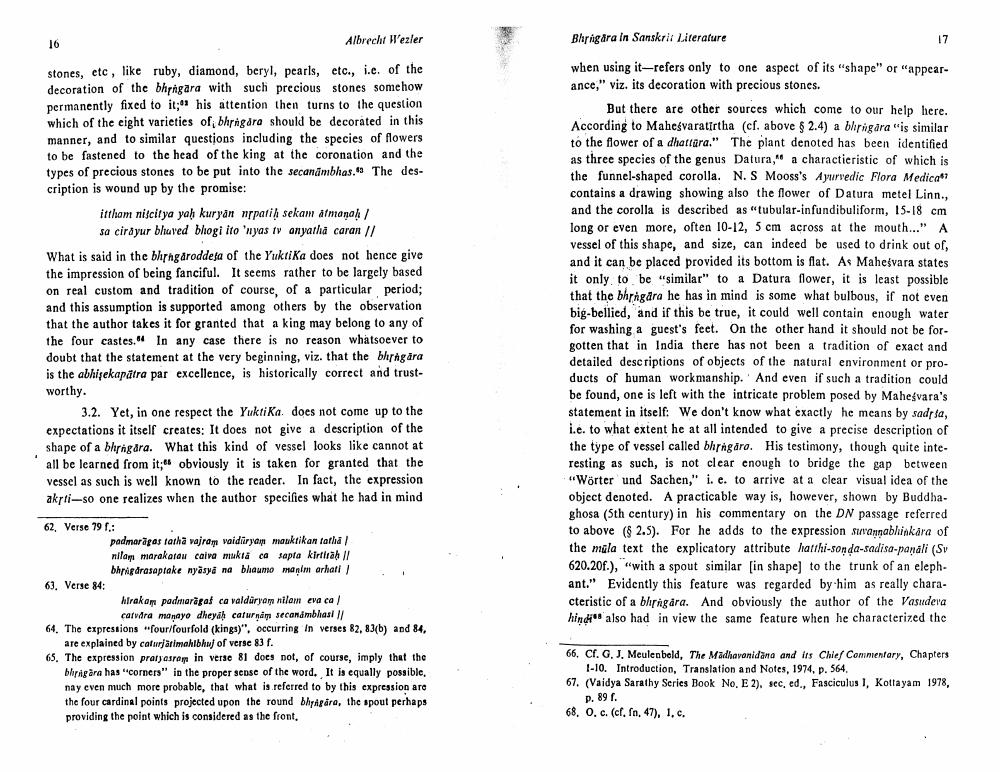Book Title: Bhrngara In Sanskrit Literature Author(s): A Wezler Publisher: A Wezler View full book textPage 9
________________ Albrecht Wezler Bhrigara in Sanskrit Literature stones, etc, like ruby, diamond, beryl, pearls, etc., i.c. of the decoration of the bhrigara with such precious stones somehow permanently fixed to it;" his attention then turns to the question which of the eight varieties of bhrigöra should be decorated in this manner, and to similar questions including the species of flowers to be fastened to the head of the king at the coronation and the types of precious stones to be put into the secanămbhas. The description is wound up by the promise: ittham niscitya yah kuryan nspatih sekam almanak / sa cirayur bhaved blogi ito 'nyas tv anyatha caran // What is said in the bhrhgaroddefa of the Yuktika does not hence give the impression of being fanciful. It seems rather to be largely based on real custom and tradition of course, of a particular period; and this assumption is supported among others by the observation that the author takes it for granted that a king may belong to any of the four castes. In any case there is no reason whatsoever to doubt that the statement at the very beginning, viz. that the bhrigara is the abhisekapätra par excellence, is historically correct and trustworthy. 3.2. Yet, in one respect the Yuktika, does not come up to the expectations it itself creates: It does not give a description of the shape of a bhrngara. What this kind of vessel looks like cannot at all be learned from it;" obviously it is taken for granted that the vessel as such is well known to the reader. In fact, the expression akrti-so one realizes when the author specifics what he had in mind when using it--refers only to one aspect of its shape" or "appearance," viz. its decoration with precious stones. But there are other sources which come to our help here. According to Mahesvaratirtha (cf. above $ 2.4) a bhrigara "is similar to the flower of a dhattara." The plant denoted has been identified as three species of the genus Datura," a charactieristic of which is the funnel-shaped corolla. N. S Mooss's Ayurvedic Flora Medical contains a drawing showing also the flower of Datura metel Linn., and the corolla is described as "tubular-infundibuliform, 15-18 cm long or even more, often 10-12, 5 cm across at the mouth..." A vessel of this shape, and size, can indeed be used to drink out of, and it can be placed provided its bottom is flat. As Mahesvara states it only to be similar" to a Datura flower, it is least possible that the bhrigara he has in mind is some what bulbous, if not even big-bellied, and if this be true, it could well contain enough water for washing a guest's feet. On the other hand it should not be forgotten that in India there has not been a tradition of exact and detailed descriptions of objects of the natural environment or products of human workmanship.' And even if such a tradition could be found, one is left with the intricate problem posed by Mahesvara's statement in itself: We don't know what exactly he means by sadra, i.e. to what extent he at all intended to give a precise description of the type of vessel called bhrigara. His testimony, though quite interesting as such, is not clear enough to bridge the gap between "Wörter und Sachen," i. e. to arrive at a clear visual idea of the object denoted. A practicable way is, however, shown by Buddhaghosa (5th century) in his commentary on the DN passage referred to above (2.5). For he adds to the expression suvarnabhinkara of the mala text the explicatory attribute hatthi-sonda-sadisa-panali (Sv 620.20f.), "with a spout similar in shape) to the trunk of an elephant." Evidently this feature was regarded by him as really characteristic of a bhrigåra. And obviously the author of the Vasudeva hind also had in view the same feature when he characterized the 62. Verse 797.: padmaräpas tarha vajram vaidūryan mauktikan tatha / nilami marakatau caiva mukta ca sapla kirtirah // bhragdrasaptake nyösya na bhaumo malm arhati / 63. Verse 84: Hirakan padmaragas ca valdūryo nilom eva ca/ carvara monayo dheyah caturnam secandmblasi! 64. The expressions "four/fourfold (kings)", occurring in verses 82, 83(b) and 84, are explained by caturjärimahibhuj of versc 83 f. 65. The expression pratyasrom in verse 81 does not, of course, imply that the bhragara has "corners" in the proper SCDSC of the word. It is equally possible. nay even much more probable, that what is referred to by this expression are the four cardinal points projected upon the round bhyagara, the spout perhaps providing the point which is considered as the front. 66. Cf. G. J. Meulenbeld, The Madhavonidana and its Chief Commentary, Chapters 1-10. Introduction, Translation and Notes, 1974, p. 564. 67. (Vaidya Sarathy Series Book No. E 2). sec, ed., Fasciculus I, Kottayam 1978, p. 89 f. 68. 0. c. (cf. fo. 47), 1.c.Page Navigation
1 ... 7 8 9 10 11 12 13 14 15 16 17 18 19 20 21 22 23
